A Reuleaux triangle is the simplest and best known Reuleaux polygon. It is a curve of constant width, meaning that the separation of two parallel lines tangent to the curve is independent of their orientation. Because all diameters are the same, the Reuleaux triangle is one answer to the question "Other than a circle, what shape can a manhole cover be made so that it cannot fall down through the hole?" The term derives from Franz Reuleaux, a 19th-century German engineer who did pioneering work on ways that machines translate one type of motion into another, although the concept was known before his time.
Contents[show] |
[edit]Construction
With a compass, sweep an arc sufficient to enclose the desired figure. With radius unchanged, sweep a sufficient arc centred at a point on the first arc to intersect that arc. With the same radius and the centre at that intersection sweep a third arc to intersect the other arcs. The result is a curve of constant width.
Equivalently, given an equilateral triangle T of side length s, take the boundary of the intersection of the disks with radius s centered at the vertices of T.
By the Blaschke–Lebesgue theorem, the Reuleaux triangle has the least area of any curve of given constant width. This area is  , where s is the constant width. The existence of Reuleaux polygons shows that diameter measurements alone cannot verify that an object has a circular cross-section.
, where s is the constant width. The existence of Reuleaux polygons shows that diameter measurements alone cannot verify that an object has a circular cross-section.
The area of Reuleaux triangle is smaller than that of the disk of the same width (i.e. diameter); the area of such a disk is  .
.
[edit]Reuleaux polygons
The Reuleaux triangle can be generalized to regular polygons with an odd number of sides, yielding a Reuleaux polygon. The most commonly used of these is the Reuleaux heptagon, which is the shape of several coins:
- Botswana pula coins in the denominations of 2 pula, 1 pula, 25 thebe and 5 thebe.
- Cypriot 50-cent coin, from 1991 until Cyprus joined the Euro in 2008.
- Jordanian quarter-dinar and half-dinar coins.
- Mauritian 10-rupee coin.
- British 20-pence and 50-pence coins.
- Canadian Loonie dollar coin. (eleven sides)
The constant width of such coins allows their use in coin-operated machines.
[edit]Other uses
- The rotor of the Wankel engine is easily mistaken for a Reuleaux triangle but its curved sides are somewhat flatter than those of a Reuleaux triangle and so it does not have constant width.[1]
- The Watts Brothers Tool Works square drill bit has the shape of a Reuleaux triangle and can, if mounted in a special chuck which allows for the bit not having a fixed centre of rotation, drill a hole that is nearly square;[2] the corners of the square are slightly rounded, as can be seen by tracing any vertex in this figure, and the drill bit covers 0.9877... of the area of the square.[3] The Harry Watt square is often used inmortising[4][5] Other Reuleaux polygons are used to drill pentagonal, hexagonal, and octagonal holes.
- A Reuleaux triangle (along with all other curves of constant width) can roll but makes a poor wheel because it does not roll about a fixed center of rotation. An object on top of rollers with cross-sections that were Reuleaux triangles would roll smoothly and flatly, but an axle attached to Reuleaux triangle wheels would bounce up and down three times per revolution. This concept was used in a science fiction short story by Poul Anderson titled "The Three-Cornered Wheel."[6]
- Several pencils are manufactured in this shape, rather than the more traditional round or hexagonal barrels.[7] They are usually promoted as being more comfortable or encouraging proper grip, as well as being less likely to roll off tables (since the center of gravity moves up and down more than a rolling hexagon).
- The shape is used for signage for the National Trails System administered by the United States National Park Service,[8] as well as the logo ofColorado School of Mines and the Connecticut Collegiate Mathematics Competition.
- Valve covers used in the Mission Bay Project of San Francisco to differentiate reclaimed water from potable water are in the shape of a Reuleaux triangle.[9]
- Among all quadrilaterals, the shape that has the greatest ratio of its perimeter to its diameter is an equidiagonal kite that can be inscribed into a Reuleaux triangle.[10]
- Many guitar picks employ the Reuleaux triangle, as its unique shape combines a sharp point to provide strong articulation, with a wide tip to produce a warm timbre. Many players find the shape ergonomic, since it naturally tends to point in the proper direction. Its three equal tips also prevent wear and extend lifespan, as compared to the single tip of a pick shaped like an isosceles triangle. [11]
[edit]Three-dimensional version
The intersection of four spheres of radius s centered at the vertices of a regular tetrahedron with side length s is called the Reuleaux tetrahedron, but is not a surface of constant width.[12] It can, however, be made into a surface of constant width, called Meissner's tetrahedron, by replacing its edge arcs by curved surface patches. Alternatively, the surface of revolution of a Reuleaux triangle through one of its symmetry axes forms a surface of constant width, with minimum volume among all known surfaces of revolution of given constant width (Campi, Colesanti & Gronchi (1996)).
[edit]See also
Reuleaux Triangle
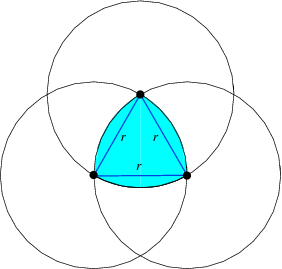
A curve of constant width constructed by drawing arcs from each polygon vertex of an equilateral triangle between the other two vertices. The Reuleaux triangle has the smallest area for a given width of any curve of constant width. Let the arc radius be ![]() . Since the area of each meniscus-shaped portion of the Reuleaux triangle is a circular segment with opening angle
. Since the area of each meniscus-shaped portion of the Reuleaux triangle is a circular segment with opening angle ![]() ,
,
(1) | |||
(2) |
But the area of the central equilateral triangle with ![]() is
is
(3) |
so the total area is then
(4) |
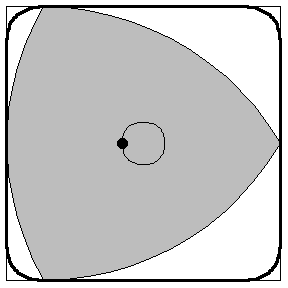
Because it can be rotated inside a square, as illustrated above, it is the basis for the Harry Watt square drill bit.
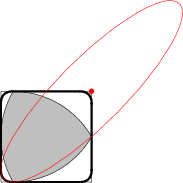 | 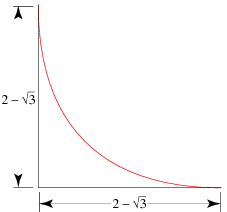 |
When rotated inside a square of side length 2 having corners at ![]() ), the envelope of the Reuleaux triangle is a region of the square with rounded corners. At the corner
), the envelope of the Reuleaux triangle is a region of the square with rounded corners. At the corner ![]() , the envelope of the boundary is given by the segment of the ellipse with parametric equations
, the envelope of the boundary is given by the segment of the ellipse with parametric equations
(5) | |||
(6) |
for ![]() , extending a distance
, extending a distance ![]() from the corner (Gleißner and Zeitler 2000). The ellipse has center
from the corner (Gleißner and Zeitler 2000). The ellipse has center ![]() , semimajor axis
, semimajor axis ![]() , semiminor axis
, semiminor axis ![]() , and is rotated by
, and is rotated by ![]() , which has the Cartesian equation
, which has the Cartesian equation
(7) |
The fractional area covered as the Reuleaux triangle rotates is
(8) |
(Sloane's A066666). Note that Gleißner and Zeitler (2000) fail to simplify their equivalent equation, and then proceed to assert that (8) is erroneous.
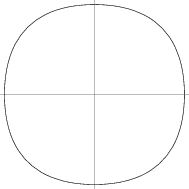 | 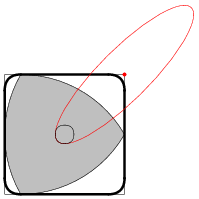 |
The geometric centroid does not stay fixed as the triangle is rotated, nor does it move along a circle. In fact, the path consists of a curve composed of four arcs of an ellipse (Wagon 1991). For a bounding square of side length 2, the ellipse in the lower-left quadrant has the parametric equations
(9) | |||
(10) |
for ![]() . The ellipse has center
. The ellipse has center ![]() , semimajor axis
, semimajor axis ![]() , semiminor axis
, semiminor axis ![]() , and is rotated by
, and is rotated by ![]() , which has the Cartesian equation
, which has the Cartesian equation
(11) |
The area enclosed by the locus of the centroid is given by
(12) |
(Gleißner and Zeitler 2000; who again fail to simplify their expression). Note that the geometric centroid's path can be closely approximated by asuperellipse
(13) |
with ![]() and
and ![]() .
.


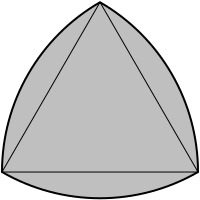




 فصل
فصل 
 پنهپ
پنهپ  عکس زیبا ترین و خوشگل ترین دختر جهان
عکس زیبا ترین و خوشگل ترین دختر جهان آخرين کلمات هرکس قبل از مرگ!
آخرين کلمات هرکس قبل از مرگ!